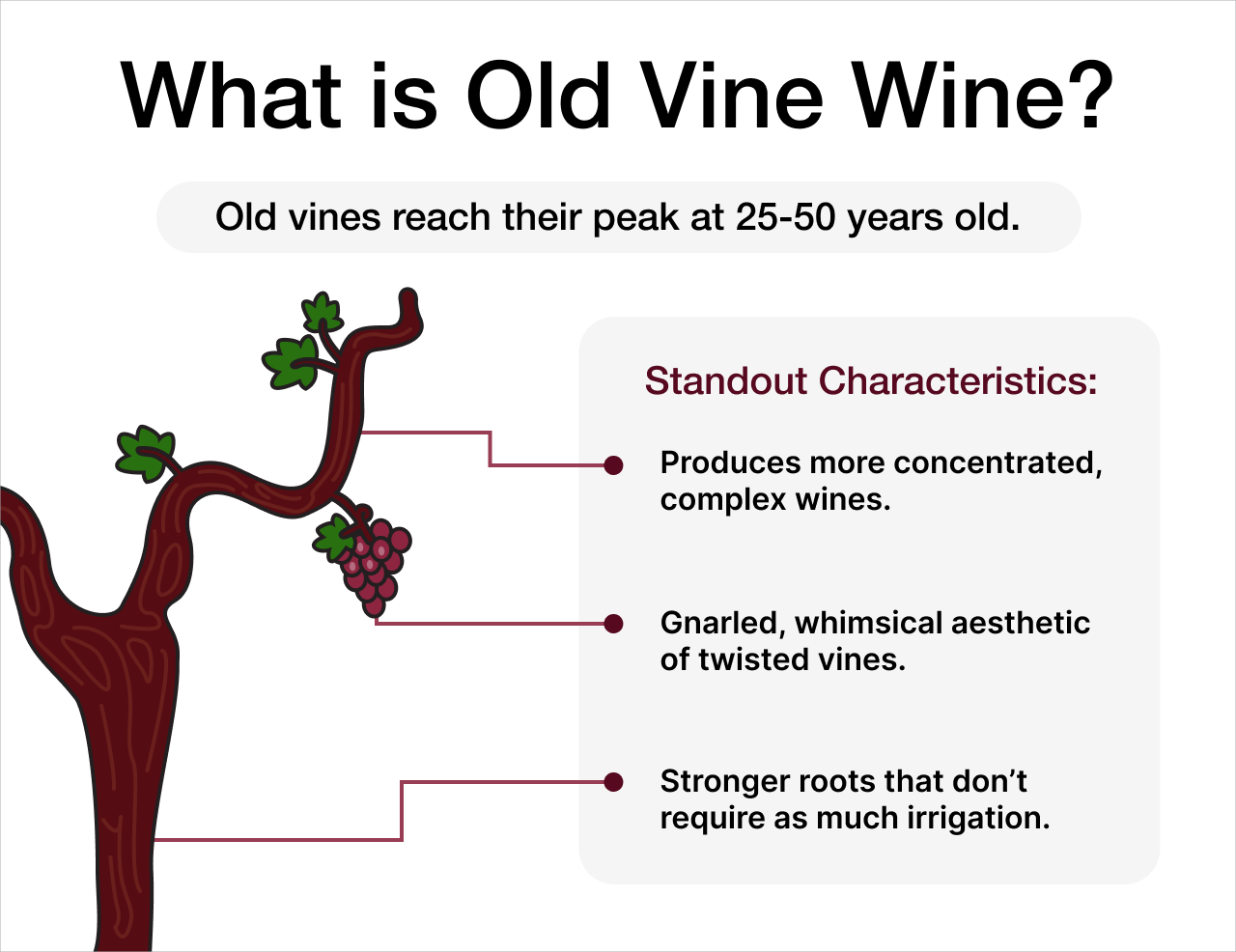
What is Old Vine Wine and is it Better?
Did you know that the national wine consumption in the United States is around 30 million liters per year?
That’s a lot of sipping, but there’s one aspect you still might be missing out on, and that’s old vine wine.
Keep reading to learn more about this exclusive wine style and why you should absolutely try it as a fellow wine enthusiast.

How Old Are Old Vines?
After just three years, vines begin producing new grapes and are considered fully mature. But what qualifies as old vine years changes depending on where you are in the world.
Wine producers in France consider a vine that’s over 20 years old to be in the “Vieilles Vignes” category, meaning “old vine.” It’s around 25 years when vines start producing smaller crops, sometimes resulting in as low as 100 bottles or less per year. This is considered peak maturity for the vine.
In other regions, such as South Africa, California, Australia, and Chile, winemakers let their vines age a little longer and don’t consider them to be old vines before 35 years. Specifically, California’s Historic Wine Society considers older vines to be around 50 years old.
How Long Do Grape Vines Last?
While 25-50 years may be considered peak maturity for most old vine grapes, there are many grapevines lasting over 100 years or more. Let’s look at some of the unique flavors and characteristics of old vine wine.
Does Old Vine Wine Taste Better?
Bursting with brighter acidity and smoother tannins than younger wines, especially in the case of red wine, old vines produce more concentrated, complex flavors. The leaves on a vintage vine are also thinner, allowing the grapes to ripen more fully.
Overall, old wine wines offer a more well-rounded palate with deeper, more complex flavors unfolding mid-palate and a distinguished earthiness you won’t find in younger wines.
Physical Characteristics of Old Vines
As a vine ages, its limbs become thicker and more gnarled, offering a more whimsical, mysterious aesthetic than younger vines. Old vines are also stronger, with deeper roots delivering constant nutrients and water. Older vines are perfect for dry farming, which is when less irrigation is needed for them to thrive.
Let’s explore where to find the oldest vineyards in the world.

How to Find Old Vines
As we unravel the mysteries behind ancient vineyards and the allure of old vine wines, let's discover the prime wine regions and grape varieties involved in old vine wine production.
Maribor, Slovenia
Slovenia stands as a rare exception in the realm of old vine wines, boasting vines as old as 400 years. Among its treasures are the Zametovka grapes, yielding wines of unparalleled rarity, with just 100 pounds of grapes annually, equivalent to around 100 miniature wine bottles. These wines command considerable prices due to their limited production.
Barossa Valley, Australia
Nestled in Southern Australia, the Barossa Valley harbors some of the continent's oldest vines, including Shiraz, Grenache, and a few Cabernet Sauvignon specimens. Notably, Turkey Flat's "The Ancestor" vine, with Shiraz dating back to 1847, stands as a testament to the region's vinicultural heritage.
Hampton Court Palace, England
Echoing centuries of history, Hampton Court Palace is home to the illustrious Great Vine, believed to be the oldest grapevine in the world. Transplanted to its current abode in 1768, this vine yields the Schiava Grossa grape, renowned for its fruity, floral, and perfumed character akin to Pinot Noir, with pronounced red berry notes and a refined structure.
Santorini, Greece
The Argyros Family Estate Vineyards on Santorini Island are renowned for cultivating the rare Assyrtiko grape, with vines bearing fruit since the early 1800s. This dry white wine exhibits vibrant lime, passion fruit, sea salt, and beeswax notes, culminating in a flinty finish that epitomizes the island's unique terroir.
Lodi, California
While Napa Valley often takes the spotlight, Lodi boasts extensive vineyards, harboring some of California's oldest heritage vines. Notably, the historic Block 4 at Spenker Ranch, Jessie's Grove, played a pivotal role in the rise of old vine White Zinfandel in the 1960s and 1970s. Today, revered vineyards like Bechthold, Royal Tee, and Charles continue to produce opulent wines dating back to the late 19th and early 20th centuries.

South Tyrol, Italy
In the picturesque region of South Tyrol resides a venerable Versoaln vine, standing steadfast for over three centuries. Nestled in Castel Katzenzungen, this vine yields grapes blended with younger varietals to craft just over 500 bottles annually. The resulting Versoaln wine delights with its smooth texture, dry palate, and invigorating acidity, accentuated by nuances of apricot and green apple.
Roanoke Island, United States
With roots tracing back to the late 1500s, Roanoke Island harbors the oldest grapevine in the United States, fondly known as the "Mother Vine." This storied vine, believed to have borne scuppernong grapes, offers a taste of history with its acidic yet sweet profile, reminiscent of the finest Southern sweet tea.
Saint Mont AOC, France
In the heart of the Saint Mont AOC lies a vine plot steeped in history, awarded the prestigious Monument Historique designation in 2012. Dating back to the early 1800s, these resilient vines survived the devastating Phylloxera epidemic, showcasing varieties such as Muscadelle, Tannat, and Fer Servadou in a testament to the region's enduring vinicultural legacy.
Don’t Forget Old Vine Wines
For your next tasting room experience, why not seek out old vine wines? If you find one of these special varietals, it will say so on the wine label.
Shop premium wines from around the world for affordable prices at Macy’s Wine Shop.
For more details on all things wine, check out The Wine Blog for exciting facts on all your favorite sippers.









